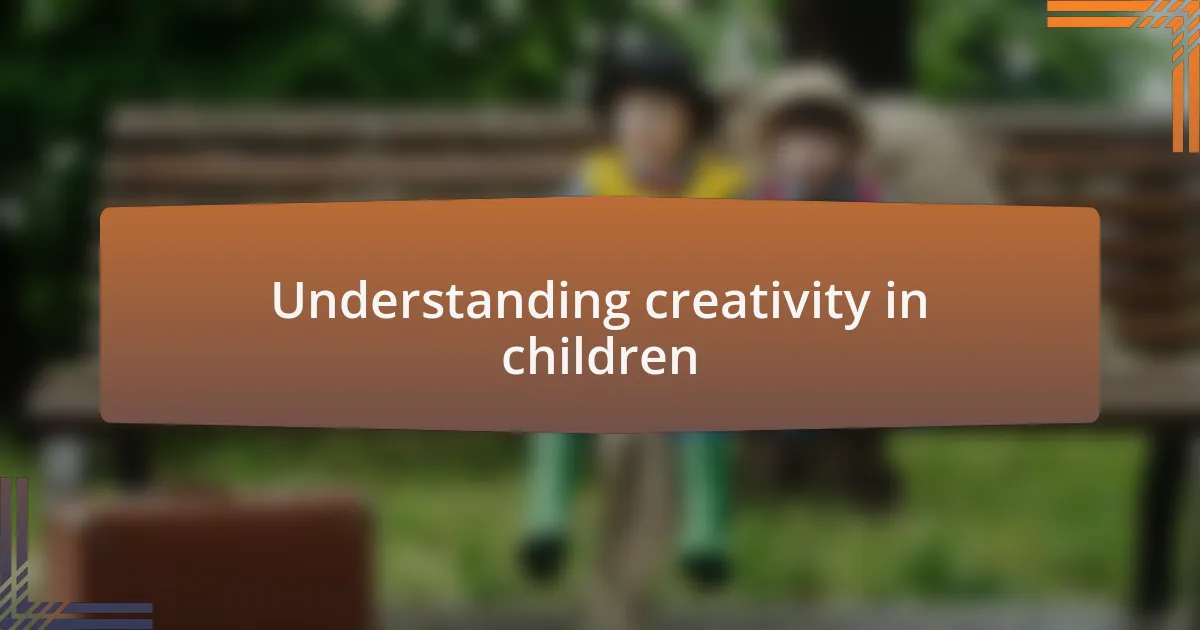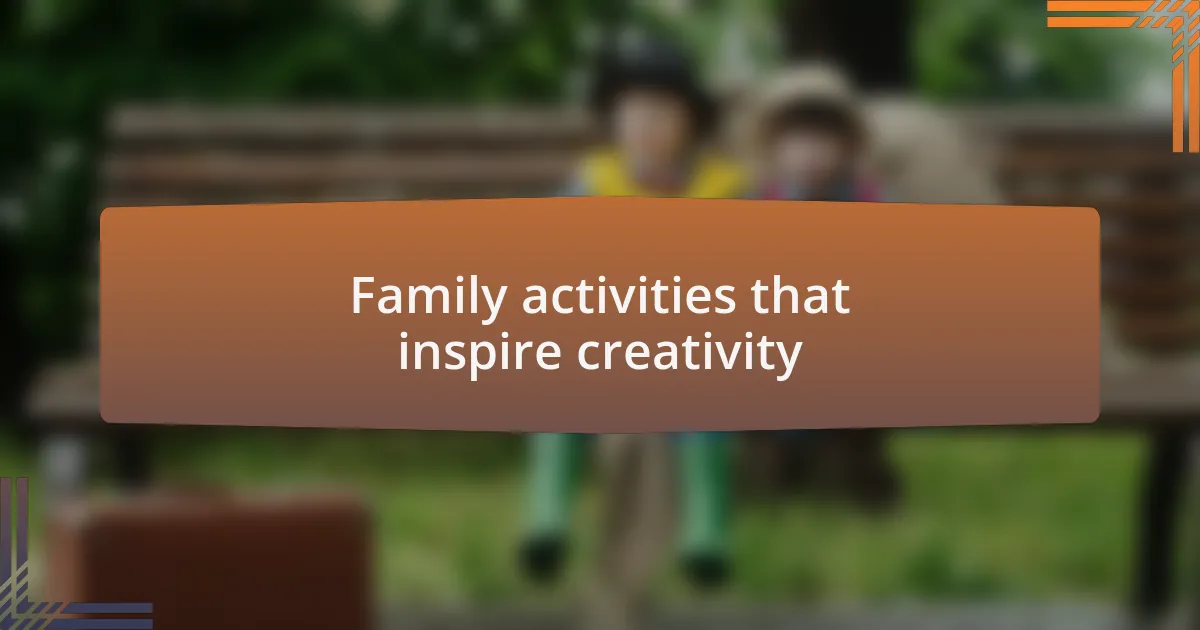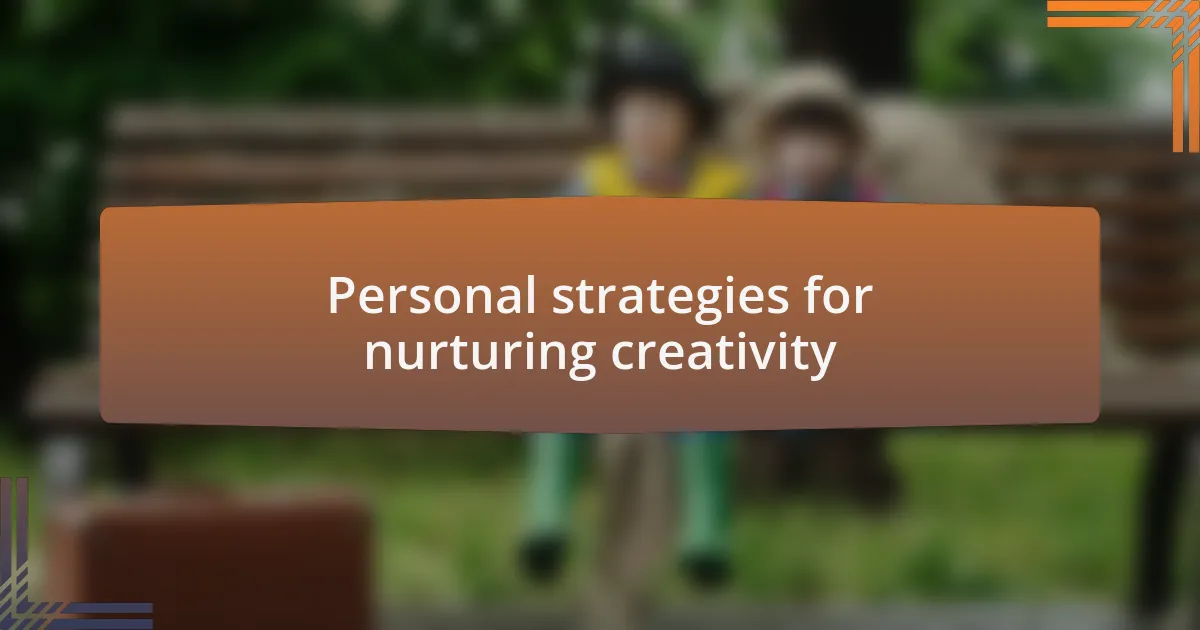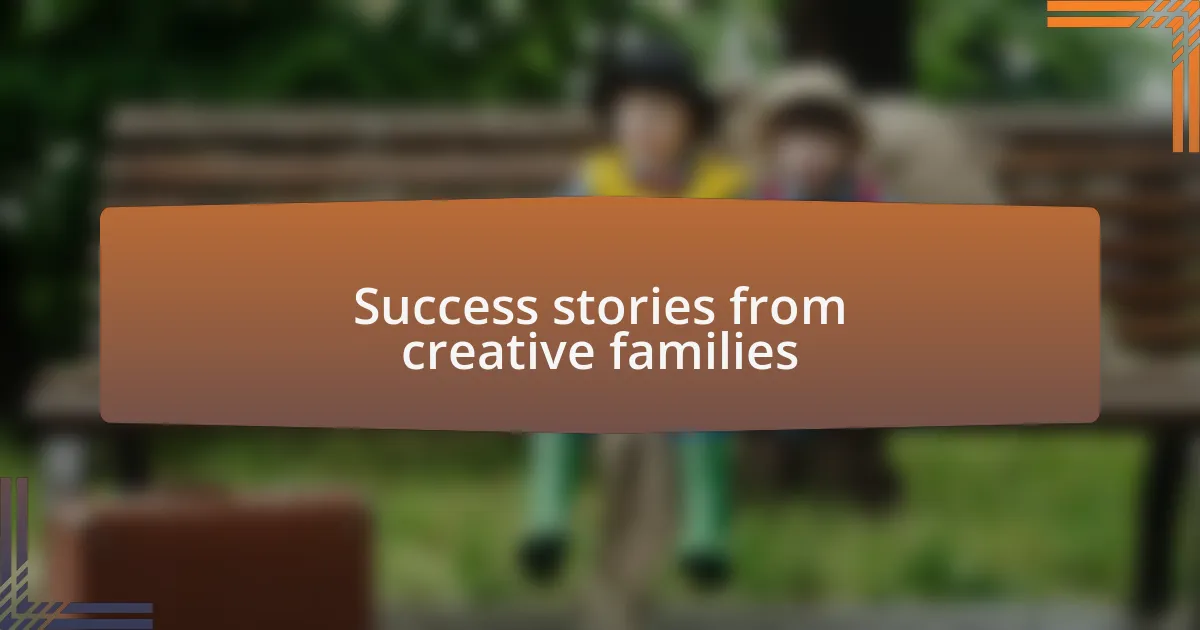Key takeaways:
- Children’s creativity manifests in various forms, from imaginative play to problem-solving, reflecting their emotional expression and innovation.
- Engaging in creative activities promotes mental health, resilience, and strengthens family connections, making it a vital aspect of development.
- Creating a conducive environment at home, such as a designated creativity space, and limiting screen time fosters children’s creative expression.

Understanding creativity in children
Creativity in children is a dynamic process that often unfolds in surprising ways. I remember watching my daughter transform a simple cardboard box into a spaceship one rainy afternoon. It dawned on me that her imagination, fueled by curiosity, allowed her to see beyond the ordinary. Isn’t it fascinating how children can turn the mundane into something extraordinary?
Understanding creativity also involves recognizing that it doesn’t always manifest as a masterpiece in art or writing. Sometimes, it’s the way a child approaches solving a problem or invents a game with their friends. I often marvel at how my son, faced with limited toys, cleverly combined different objects to create an elaborate obstacle course. This ability to innovate is a vital part of their developmental journey.
Moreover, emotional expression is at the heart of creativity. Children often pour their feelings into their creations, communicating what may be hard for them to express otherwise. I recall a time when my youngest drew a vivid picture that represented her feelings after a tough day at school. That piece of art held so much depth; it made me realize how important it is to nurture these moments. How can we create an environment that encourages our children to express themselves freely and creatively?

Importance of creativity for health
Creativity plays a fundamental role in promoting mental health and emotional well-being. I often notice that when my children engage in creative activities, such as drawing or building, they seem more at ease and connected to their emotions. It’s almost as if they are releasing pent-up feelings in a healthy, constructive way. Have you ever seen how a simple art project can lift a child’s spirits?
Participating in creative pursuits also fosters resilience. I remember when my son faced failure during a school talent show. Instead of being discouraged, he channeled that disappointment into revising his performance for the next year. This process nurtured his problem-solving skills while reinforcing that setbacks are simply a part of growth. Isn’t it inspiring how creativity can teach our children to bounce back stronger?
Moreover, creativity can foster connection within the family. I think back to evenings spent around the kitchen table, crafting holiday decorations together. Those moments weren’t just about art; they strengthened our bonds and created lasting memories. It makes me wonder how we can further utilize creativity to enhance our collective mental health and resilience as a family.

Family activities that inspire creativity
Exploring nature through family hikes can be a fantastic way to spark creativity. Recently, my family and I took a walk in the woods, and I encouraged my kids to collect interesting leaves and stones. When we returned home, we transformed those natural treasures into a vibrant collage. It was remarkable to see how a simple walk could fuel their imagination and turn an ordinary day into an artistic adventure. Have you ever noticed how nature inspires children to see the world differently?
Cooking together can also unleash creativity in unexpected ways. I remember one Saturday when we decided to hold a “make your own pizza” night. Each family member got to design their own pizza with various toppings. The kitchen erupted in laughter as they experimented with combinations that sounded outrageous but tasted surprisingly good! I realized that cooking wasn’t just about the meal; it was an opportunity for self-expression. Have you ever thought about how a kitchen can become a canvas for creativity?
Reading stories aloud and then acting them out can ignite imaginative play. One rainy afternoon, I read a story about a dragon who fancied himself a ballet dancer. Inspired by the tale, my kids grabbed costumes and created their own interpretation of the story, complete with dramatic dance moves and funny sound effects. It was fascinating to see them embrace the narrative in such a lively way. Isn’t it wonderful how creativity can transform a simple story into a shared family experience?

Encouraging creative expression at home
One of the simplest yet most effective ways to encourage creative expression at home is through art projects. I vividly recall an afternoon when my children and I set up an art station in our living room, stocked with paper, paints, and crayons. The transformation was delightful; they lost themselves in colors and shapes, each creating pieces that reflected their unique perspectives. Have you seen how art allows children to express feelings and thoughts that they might not verbalize? It’s a beautiful thing to witness.
Music is another powerful medium for creativity. I remember a rainy evening when we turned our living room into a mini concert hall. Each family member chose an instrument—whether it was a guitar, keyboard, or even makeshift drums—creating a spontaneous jam session. The joy in their faces as they improvised and experimented with sounds was contagious. How often do we forget that making music together can strengthen our bonds and unleash creativity?
Even simple story creation can encourage imaginative thinking. One day, we decided to craft a family story, each person contributing one sentence at a time. The twists and turns our tale took were hilarious but also eye-opening; it showed me how collaboration could lead to unexpected creativity. Have you ever tried weaving stories with your kids? It’s fascinating to see where their imaginations can take you if you just give them a little nudge!

Personal strategies for nurturing creativity
Creating a creative environment at home is pivotal. I remember deciding to dedicate a corner of our living room as a creativity zone, filled with crafting supplies, puzzles, and books. Every day after school, it transformed into a haven where my children could explore their interests freely. Have you thought about how a dedicated space can liberate young minds to experiment with their creativity without boundaries?
Another strategy I’ve found helpful is to embrace play as a form of learning. One rainy afternoon, we played a game where we constructed a city using blocks, each of us naming different buildings and the stories behind them. Watching my kids get lost in this imaginative play reminded me how open-ended games can spark original ideas and innovative thinking. When was the last time you let your kids’ imaginations run wild during playtime?
Limiting screen time is crucial for fostering creativity. Instead of defaulting to tablets or TVs, I initiated “creativity nights,” where we would engage in crafting, storytelling, or even cooking new recipes together. I discovered that these evenings not only generated new ideas but also deepened our family connections. Have you noticed how interactive experiences can ignite creativity far more effectively than passive consumption?

Success stories from creative families
Success stories from creative families often reveal how simple ideas can lead to profound experiences. I recall a family I spoke with who transformed their backyard into an art studio. Each weekend, they would hold community art days, inviting neighbors and friends to join in on the fun. This not only fostered creativity in their own children but also built stronger bonds within their community. Have you ever considered how sharing creative experiences can amplify inspiration?
Another inspiring tale comes from a family that incorporated storytelling into their bedtime routine. They took turns creating fantastical adventures, with each night building on the previous episode. This ritual didn’t just enrich their children’s creativity; it sparked a love for storytelling that resulted in their kids writing their own stories. How powerful is it to witness children developing their own narratives, right from the comfort of their home?
One more story that resonates with me is about a family that embraced cooking as a canvas for creativity. They set up a monthly “Family Cook-Off,” where each member would present a dish inspired by a theme. I found it intriguing how this not only nurtured their culinary skills but also encouraged collaboration and innovation in the kitchen. Have you ever thought about how involving kids in cooking can lead to delicious discoveries and strengthen family ties?